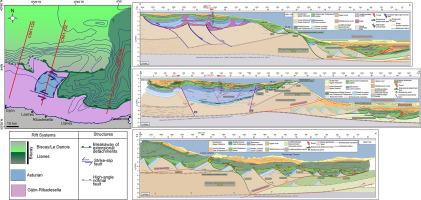当前位置:
X-MOL 学术
›
Gondwana Res.
›
论文详情
Our official English website, www.x-mol.net, welcomes your
feedback! (Note: you will need to create a separate account there.)
Unravelling the architecture and evolution of the inverted multi-stage North Iberian-Bay of Biscay rift
Gondwana Research ( IF 7.2 ) Pub Date : 2020-12-01 , DOI: 10.1016/j.gr.2020.06.026 Patricia Cadenas , Gianreto Manatschal , Gabriela Fernández-Viejo
Gondwana Research ( IF 7.2 ) Pub Date : 2020-12-01 , DOI: 10.1016/j.gr.2020.06.026 Patricia Cadenas , Gianreto Manatschal , Gabriela Fernández-Viejo

|
Abstract Current rift models propose polyphase rift evolutions that develop with the same kinematic framework and accommodate continuous and sequential extension, through the stacking of deformation modes. Several rifted margins show, however, evidence for multiple and out of sequence rift events, which developed within different kinematic frameworks, with a complex spatial and temporal evolution. In this work, we address the problem of multi-stage rift systems based on the study of the central North Iberian margin, located at the southern Bay of Biscay triangular oceanic domain. This magma-poor rifted margin recorded three major Mesozoic rift events and a subsequent Alpine compressional reactivation, representing a unique setting to study the architecture of a multi-stage rift system and the exerted control on subsequent reactivation. Relying on a dense set of 2D seismic reflection profiles, boreholes, and published velocity models, we map and describe structural domains and major extensional and compressional structures, and we construct depth and thickness maps of syn-rift units. These new maps display the geometry and spatial distribution of major rift basins and bounding structures. Distinctive scenarios resulting from this tectono-stratigraphic approach led us to define three rift systems. A first, diffuse and widespread Triassic system, with classical fault-bounded half-graben basins; a second, narrow, deep and localised Late Jurassic to Barremian transtensional system, including laterally confined pull-apart basins; and a third, widely distributed Aptian to Cenomanian hyperextended system. Our results show that each rift system controlled the successive extensional and compressional events, resulting in a complex 3D template. Deciphering the tectono-stratigraphic architecture of such, multi-stage systems provide key insights on the spatial, temporal, and thermal evolution of divergent plate boundaries. It is likewise indispensable to propose and test kinematic plate deformable models on conjugate rifted margins and to comprehend the implications for their reactivation.
中文翻译:

解开倒立的多级北伊比利亚-比斯开湾裂谷的结构和演化
摘要 当前的裂谷模型提出了多相裂谷演化,该演化具有相同的运动学框架,并通过变形模式的叠加来适应连续和顺序扩展。然而,几个裂谷边缘显示了多重和无序裂谷事件的证据,这些裂谷事件在不同的运动学框架内发展,具有复杂的时空演化。在这项工作中,我们基于对位于比斯开湾南部三角洋域的北伊比利亚边缘中部的研究,解决了多级裂谷系统的问题。这个岩浆贫乏的裂谷边缘记录了三个主要的中生代裂谷事件和随后的阿尔卑斯压缩再活化,代表了研究多级裂谷系统结构和对随后再活化的施加控制的独特环境。依靠一组密集的 2D 地震反射剖面、钻孔和已发布的速度模型,我们绘制和描述了构造域以及主要的拉伸和压缩构造,并构建了同裂谷单元的深度和厚度图。这些新地图显示了主要裂谷盆地和边界结构的几何形状和空间分布。这种构造地层学方法产生的独特情景使我们定义了三个裂谷系统。第一个广泛分布的三叠纪系统,具有经典的断层边界半地堑盆地;第二个狭窄的、深的和局部的晚侏罗纪到巴雷米亚的张张系统,包括横向限制的拉开盆地;第三个,广泛分布的 Aptian 到 Cenomanian 超扩展系统。我们的结果表明,每个裂谷系统都控制着连续的拉伸和压缩事件,从而产生了一个复杂的 3D 模板。破译这种多阶段系统的构造地层结构提供了关于发散板块边界的空间、时间和热演化的关键见解。在共轭裂隙边缘提出和测试运动学板可变形模型并理解其重新激活的含义同样是必不可少的。
更新日期:2020-12-01
中文翻译:

解开倒立的多级北伊比利亚-比斯开湾裂谷的结构和演化
摘要 当前的裂谷模型提出了多相裂谷演化,该演化具有相同的运动学框架,并通过变形模式的叠加来适应连续和顺序扩展。然而,几个裂谷边缘显示了多重和无序裂谷事件的证据,这些裂谷事件在不同的运动学框架内发展,具有复杂的时空演化。在这项工作中,我们基于对位于比斯开湾南部三角洋域的北伊比利亚边缘中部的研究,解决了多级裂谷系统的问题。这个岩浆贫乏的裂谷边缘记录了三个主要的中生代裂谷事件和随后的阿尔卑斯压缩再活化,代表了研究多级裂谷系统结构和对随后再活化的施加控制的独特环境。依靠一组密集的 2D 地震反射剖面、钻孔和已发布的速度模型,我们绘制和描述了构造域以及主要的拉伸和压缩构造,并构建了同裂谷单元的深度和厚度图。这些新地图显示了主要裂谷盆地和边界结构的几何形状和空间分布。这种构造地层学方法产生的独特情景使我们定义了三个裂谷系统。第一个广泛分布的三叠纪系统,具有经典的断层边界半地堑盆地;第二个狭窄的、深的和局部的晚侏罗纪到巴雷米亚的张张系统,包括横向限制的拉开盆地;第三个,广泛分布的 Aptian 到 Cenomanian 超扩展系统。我们的结果表明,每个裂谷系统都控制着连续的拉伸和压缩事件,从而产生了一个复杂的 3D 模板。破译这种多阶段系统的构造地层结构提供了关于发散板块边界的空间、时间和热演化的关键见解。在共轭裂隙边缘提出和测试运动学板可变形模型并理解其重新激活的含义同样是必不可少的。











































 京公网安备 11010802027423号
京公网安备 11010802027423号